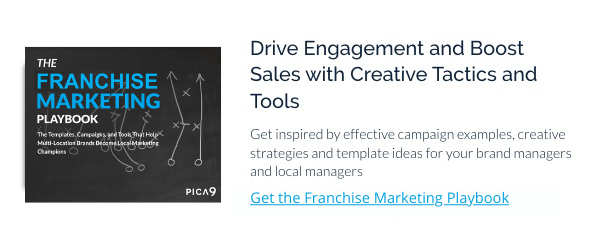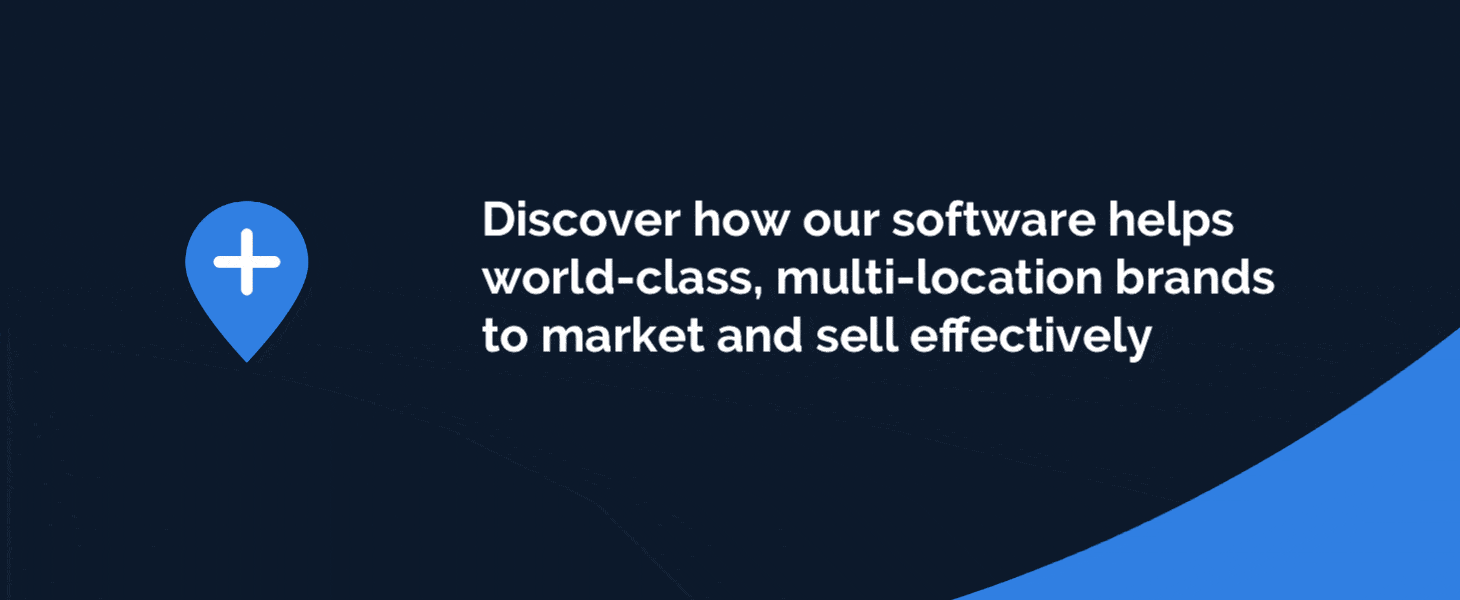As a brand manager for a franchise brand, your job is to ensure a consistent customer experience across all of your locations. Your customers expect the same experience at all of your brand's outlets. Knowing this, both you and your team work hard to provide local teams with everything they need to deliver a consistent customer experience - from handbooks on franchise operations to company culture. But, what about your brand's marketing consistency?
"A promise, of course, is good only if it’s kept," writes marketing professor Dr. Lee Frederiksen. He continues: "If a company doesn’t deliver on its promise the vast majority of the time, its reputation—and sales—will...decline."
For franchise brands delivering on the brand's promise is ultimately delivered through the marketing and business operations that each individual franchisee runs. In this post, we'll explore how brand managers can use centralized asset management to help these franchisees fulfill brand promise every time.
Why Consistent Customer Experiences are Everything
Consistency really is crucial. In fact, a McKinsey study of 27,000 American consumers found that the “three C’s” of a positive customer experience are:
- Customer journey consistency
- Emotional consistency
- Communication consistency
Consistency can be particularly difficult to achieve in a distributed brand setting. But that doesn't make it any less crucial. Your customers need to trust that they’ll experience the same quality of service at every one of your franchise locations worldwide.
How do brand managers ensure that the customer experience “looks” consistent (in terms of marketing materials like direct mail campaigns, in-store signage, and other materials)?
The key is centralized asset management.
What is Centralized Asset Management?
Centralized asset management (CAM) is a marketing term used to describe a centralized method of controlling and managing brand assets in order to execute a consistent customer experience across brand locations or channels. For distributed brands, centralized asset management needs to involve the flexibility to use the same design devices while also including specific local information, such as the address of a franchised restaurant.
To be clear, CAM is NOT software or a type of technical tool. It’s not even something that’s unique to distributed marketing - any brand can benefit from approaching asset management in a centralized way.
However, centralized asset management is particularly important for distributed brands due to the critical balance between control and relevance in local marketing execution. Local marketers need to be able to modify campaigns to fit their local market, while maintaining branded elements, like logo and typography, that contribute to brand consistency.
Centralized Asset Management Terms to Know
CAM can be enabled by marketing technologies. To support your understanding of what CAM is, within a distributed marketing setting, we’ve included a list of terms that may be associated with CAM:
- Collateral management: Also referred to as marketing collateral management (MCM), this is typically a tool or category of software used to manage the status, ownership, access, and distribution of digital and print marketing assets.
- Digital Asset Management: DAM systems are technologies for organizing, storing, and retrieving marketing assets.
- Media Asset Management: MAM is a concept closely related to DAM, but it speaks to technologies, or parts of tools, specifically focused on the storage and retrieval of media files such as audio or video.
- Marketing Resource Management: MRM tools are a category of software used to support broad marketing activity, which can include planning, budgeting, creative development, content management, and reporting.
- Local Marketing Automation: LMA technologies are used to create efficiency and streamline processes related to marketing execution at the local level.
Of the five concepts and tools listed above, not a single one is equivalent to centralized asset management. MRM, DAM, and LMA tools can be used to enable CAM at an organization; however, they’re certainly not synonymous.
How Do You Achieve Franchise Centralized Asset Management?
While your franchisees may not always have a marketing background, they're certainly invested in the success of their business. As a brand manager, your challenge is to overcome the fact that local marketers don't always have the time for marketing – or an understanding of branding that enables them to make the right decisions for asset modification and use.
Tactics that brand managers use to help achieve centralized asset management in a distributed setting include:
- Implement a Co-Op, or market development funds (MDF), program to reward your franchisees who use your pre-approved advertising campaigns. Note, these programs can be time-consuming to manage.
- Expand your franchise handbook to include best practices for localized marketing, asset management, and examples of complaint vs. non-compliant marketing, in addition to standard procedures and policies.
- Create a visual style guide and checklist to ensure your franchisees have a quick and handy guide to use if they choose to create their own assets for marketing.
- Develop a tone and messaging guide and share it regularly.
- Curate examples of successful and not-so-successful franchise marketing to educate your franchisees on what excellence looks like.
- Create a set of basic art and design objects for franchisees to use. To ensure they're adopted, create easy-to-use file formats, as many franchisees will not know the difference between a PNG and JPEG - let alone sufficient have sufficient knowledge of InDesign to edit and use the files.
- Develop templates for local partners to create customized marketing assets. You may have to use simplified formats like Microsoft Word or PowerPoint. However, templates will allow your franchisees to add their own messages while still sticking to brand guidelines.
- Establish expectations for one-off design jobs and create a standardized creative brief for unique design requests. With a simple service level agreement (SLA), your franchisees will know what to expect when they're submitting custom design requests.
As you can see, you can attempt to achieve CAM with a pure business processes. However, you are unlikely to achieve enough oversight, and consistency could fall by the wayside for local marketers struggling to understand campaign vision or brand guidelines.
CAM is not a specific marketing technology, yet achieving all eight of these processes without technology can be almost impossible. For distributed brands, the right local marketing automation (LMA) tool can change everything and enable CAM for your organization.
What Happens When You Add Technology?
Local marketing automation (LMA) streamlines the process of achieving CAM and consistent customer experiences at all of your locations. Since the needs of distributed organizations vary, CAM is rarely one-size-fits-all. In fact, any LMA solution that lacks flexibility around customization could hinder your efforts to achieve consistent local marketing execution. The right LMA tool allows brand managers to strike a balance between control and flexibility.
From a feature set perspective, LMA tools that support effective CAM for distributed brands may include:
- Asset Management: Comprehensive coverage for all types of marketing assets your locals need, including print, digital, email, social media, and more.
- Asset Search: Including any combination of download, editing, conversion, and sharing.
- Asset Uploading: Depending on the structure of your distributed brand, both designers and local marketing representatives may need the ability to upload and tag assets.
- Content Metadata Tagging: The ability to efficiently tag assets by campaign and other attributes can enable local marketers to easily retrieve what they’re looking for through search.
- Template Customization: Including any combination of template permissions such as text, imagery, formatting, materials, and design control customization.
- Custom material creation: Allowing brand designers, and in some cases franchise marketers, to add pages, create new text layers, add their own logos or pictures, and more.
With the help of the above six tools, brand managers have the ability to set customized permissions depending on their franchisee's needs. You may need to require approval for all creative actions while requiring no approvals for other local actions. In addition, the right local marketing automation software allows brand managers to control the permissions at a geographic level for fine-tuned local marketing.
Using Technology for Franchise Centralized Asset Management
Centralized asset management systems make the workflow and execution challenges of franchise brand management much easier - especially with a tool like CampaignDrive. Add templates and assets, lock down your assets to preserve brand integrity, and release the collateral to your franchisees all within one centralized tool.
The benefits of a tool like CampaignDrive for asset management include:
- Ease of access via 24/7 cloud access
- Control through user permissions and franchisee segmentation
- Ability to establish workflows for marketing content, information, and design
Enable your local marketers to deliver on the brand promise by approaching centralized asset management in a way that allows for flexible asset creation, and creativity, while still protecting the brand.
To learn more about how some of the world's biggest distributed brands excel at centralized asset management: Download our free eBook Distributed Marketing on Steroids: The Brand Manager’s Guide to Designing and Managing Local Marketing Assets Without Breaking a Sweat.






